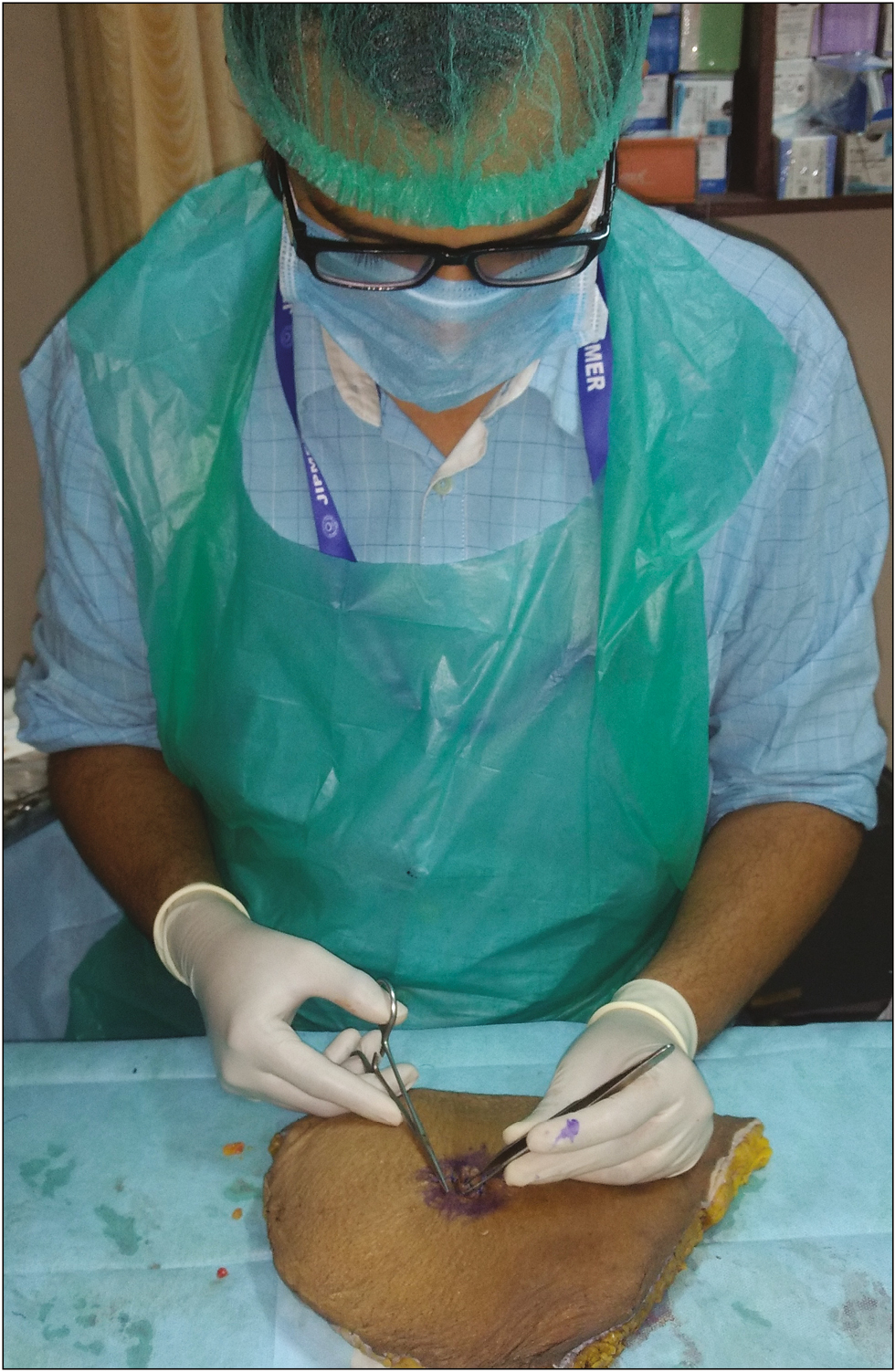Translate this page into:
Innovative Use of Abdominoplasty Specimen
Address for correspondence: Dr. Ravi Kumar Chittoria, Department of Plastic Surgery, Jawaharlal Institute of Postgraduate Medical Education and Research (JIPMER), Puducherry 605006, India. E-mail: drchittoria@yahoo.com
This is an open access journal, and articles are distributed under the terms of the Creative Commons Attribution-NonCommercial-ShareAlike 4.0 License, which allows others to remix, tweak, and build upon the work non-commercially, as long as appropriate credit is given and the new creations are licensed under the identical terms.
This article was originally published by Medknow Publications & Media Pvt Ltd and was migrated to Scientific Scholar after the change of Publisher.
Abstract
Simulator training is important for understanding nipple–areolar complex reconstruction. Human tissue is the best tissue simulator for surgical training. Abdominoplasty specimen is a useful tissue simulator, which is suitable for practicing nipple–areolar complex reconstruction. It is similar to the natural mound created in breast reconstruction. Authors have shared their experience of using abdominoplasty specimen for simulator training of nipple–areolar complex reconstruction for plastic surgery residents. Abdominoplasty specimen is cost-effective, readily available, and an efficient tool for plastic surgery training for the residents.
Keywords
Abdominoplasty specimen
nipple–areolar reconstruction
plastic surgery trainee
tissue simulator
Abdominoplasty specimen is a useful tissue simulator suitable for practicing nipple-areolar complex reconstruction. It is cost-effective, readily available, and an efficient tool for plastic surgery training for the residents.

INTRODUCTION
Simulation training is very important for a plastic surgery trainee before operating on live patients. For flap surgery training, human tissue provides the best simulation as it is the natural skin with subcutaneous fat and fascia. Father of Modern Plastic Surgery, Sir Harold Gillies, had quoted that “never throw anything away.”[1] In some plastic surgery procedures, healthy tissue is excised, which need not be sent for pathological examination. This human tissue can be used for surgical practice.[2] One such procedure is the abdominoplasty.
Abdominoplasty is a commonly performed procedure. The idea of using abdominoplasty specimen for surgical training has already been described.[3] Abdominoplasty specimen can be used for the practice of suturing techniques, skin graft harvesting (split thickness and full thickness), fat graft harvesting, and local fasciocutaneous flaps.[34] The practice of flaps for designing new nipple or umbilicus over abdominoplasty specimen has also been proposed.[5] Here, we share our experience of using abdominoplasty specimen as a simulator for training plastic surgery residents in the creation of new nipple.
MATERIALS AND METHODS
A hands-on workshop on local flap techniques of nipple reconstruction was organized at our institute. Six plastic surgery trainee residents participated in this workshop. We used abdominoplasty specimens from three patients operated at our institute. Each specimen was divided into two pieces, and one piece was provided to each participant. Written informed consent was obtained from all the patients. Under the guidance of consultant plastic surgeon, the participants designed local flaps and created new nipple–areolar complex (NAC) over these specimens. Multiple flaps were practiced over one specimen. At the end of the workshop, the participants gave their feedback in written format [Figures 1 and 2].

- C-V flap nipple reconstruction over abdominoplasty specimen

- Resident practicing nipple reconstruction over abdominoplasty specimen
RESULTS
The feedback responses of the participants after completion of the workshop are shown in Table 1.

DISCUSSION
NAC reconstruction is a challenging surgery with multiple possible reconstructive options. Some of the local flaps for nipple reconstruction are skate flap, star flap, C-V flap, arrow flap, bell flap, top hat flap, S-flap, and spiral flap.[6] Each method of nipple reconstruction has unique characteristics. It is important to understand all these methods to make a correct decision regarding NAC reconstruction.
The nipple is reconstructed over the breast mound, and the techniques are based on the use of subcutaneous fat along with the skin. The abdominoplasty specimen is similar to the breast mound. The abdominoplasty specimen consists of the skin, fat, and superficial fascia from the lower abdomen. The same tissue is commonly used for the breast mound reconstruction in pedicled or free transverse rectus abdominis myocutaneous flap. Again, the skin and fat content of abdomen is similar to the skin and fat content of back tissue, which is transposed during latissimus dorsi flap. Abdominoplasty is a common procedure, and the specimen is readily available in the plastic surgery department. The specimen can be preserved in formalin. It does not cost any extra charges.
In our experience, practicing NAC reconstruction over abdominoplasty specimen is useful for the plastic surgery residents. All the participants found this workshop helpful in understanding different flap techniques. Designing and operating these flaps increased their confidence level and refined their skills. The participants suggested for arranging such workshops frequently. They pointed out that preserving the specimen negatively affects the quality of tissue simulator, and a fresh specimen is better for the flap practice.
CONCLUSION
Abdominoplasty specimen is a useful tissue simulator suitable for practicing NAC reconstruction. It is cost-effective, readily available, and an efficient tool for plastic surgery training for the residents. Preferably fresh specimen should be used for the flap practice.
Financial support and sponsorship
Department of Plastic Surgery, Jawaharlal Institute of Postgraduate Medical Education and Research (JIPMER), Puducherry, provided the funding for this project.
Conflicts of interest
There are no conflicts of interest.
REFERENCES
- The principles and art of plastic surgery. Boston, MA: Little Brown; 1957.
- Innovative usage of accessory auricles as full-thickness skin graft. J Cutan Aesthet Surg. 2017;13:150-2.
- [Google Scholar]
- Useful material for skin flap training for inexperienced residents. J Plast Reconstr Aesthet Surg. 2007;13:1169-70.
- [Google Scholar]
- Versatile uses of abdominoplasty specimen for young trainees. Plast Reconstr Surg. 2009;13:335-6; author reply 336.
- [Google Scholar]
- Versatile uses of abdominoplasty specimen for young trainees Reply. Plast Reconstr Surg. 2009;13:336.
- [Google Scholar]
- Reconstruction of the nipple areolar complex. In: Neligan PC, ed. Plastic surgery principles. Vol Vol. 5. Edinburgh, Scotland: Elsevier; 2018. p. :501-8.
- [Google Scholar]





